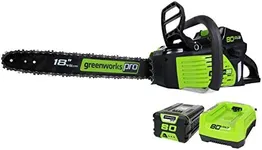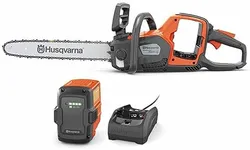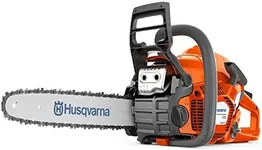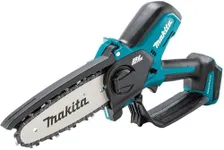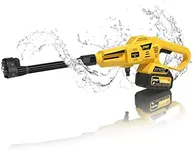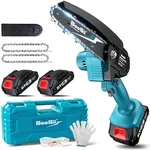Buying Guide for the Best Lightweight Chainsaws
Choosing the right lightweight chainsaw can make your cutting tasks easier and more efficient. Whether you're trimming branches, cutting firewood, or tackling small trees, a lightweight chainsaw can provide the power you need without the bulk and fatigue associated with heavier models. To find the best fit for you, it's important to understand the key specifications and how they align with your specific needs.WeightWeight is a crucial factor when selecting a lightweight chainsaw, as it directly affects your comfort and ease of use. Lightweight chainsaws typically range from 5 to 10 pounds. If you plan to use the chainsaw for extended periods or have limited upper body strength, opt for a model on the lighter end of the spectrum. For occasional use or shorter tasks, a slightly heavier model may still be manageable and offer additional power.
Power SourceChainsaws can be powered by gas, electricity, or batteries. Gas-powered chainsaws are generally more powerful and suitable for heavy-duty tasks but are also heavier and require more maintenance. Electric chainsaws are lighter and easier to maintain, making them ideal for small to medium tasks around the yard. Battery-powered chainsaws offer the convenience of cordless operation and are lightweight, but their runtime is limited by battery life. Choose a power source based on the type and frequency of tasks you plan to perform.
Bar LengthThe bar length of a chainsaw determines the size of the wood it can cut. Lightweight chainsaws typically have bar lengths ranging from 10 to 16 inches. A shorter bar (10-12 inches) is easier to handle and ideal for trimming branches and cutting small logs. A longer bar (14-16 inches) can handle larger logs and small trees but may add some weight and require more control. Consider the typical size of the wood you'll be cutting to choose the appropriate bar length.
Engine/Motor PowerThe power of a chainsaw's engine or motor is measured in cubic centimeters (cc) for gas models or amps/volts for electric and battery models. Higher power ratings provide more cutting capability but can also add weight. For light pruning and small tasks, a lower power rating (20-30cc or 8-12 amps/18-20 volts) is sufficient. For more demanding tasks, such as cutting thicker logs, a higher power rating (30-40cc or 12-15 amps/36-40 volts) may be necessary. Match the power to the intensity of your cutting needs.
Safety FeaturesSafety features are essential in any chainsaw to prevent accidents and injuries. Look for features such as chain brakes, low kickback bars, and automatic oilers. Chain brakes stop the chain quickly in case of kickback, while low kickback bars reduce the risk of kickback occurring. Automatic oilers ensure the chain remains lubricated, reducing wear and the risk of malfunction. Prioritize models with robust safety features, especially if you are a beginner or will be using the chainsaw frequently.
Ease of MaintenanceRegular maintenance is necessary to keep your chainsaw in good working condition. Features that simplify maintenance include tool-less chain tensioning, easy access to the air filter and spark plug (for gas models), and clear oil level indicators. Tool-less chain tensioning allows you to adjust the chain without additional tools, saving time and effort. Easy access to maintenance points ensures you can perform routine checks and replacements quickly. Choose a model with user-friendly maintenance features to keep your chainsaw running smoothly.
